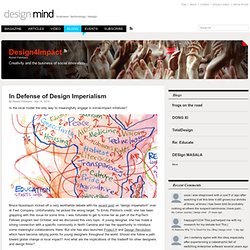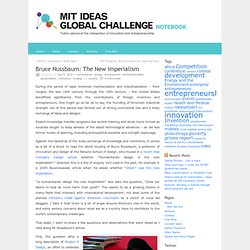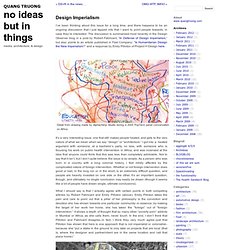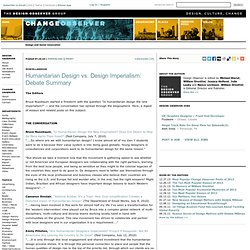

Is Humanitarian Design the New Imperialism? Emily Pilloton's Design Revolution Road Show, the physical embodiment of her non-profit Project H Design rolled into New York a few weeks ago stopping at Metropolis, the Cooper Hewitt National Design Museum and ICFF. Yes, Project H is hot in U.S. and European design circles, almost as sizzling as IDEO, the Acumen Fund, and One Laptop Per Child. And why not? Emily’s Project H is a pure play in using design to do good. It doesn’t get better than this mission statement: In Defense of Design Imperialism. By Robert Fabricant - July 15, 2010 Is the local model the only way to meaningfully engage in social-impact initatives?

Bruce Nussbaum kicked off a very worthwhile debate with his recent post on “design imperialism” over at Fast Company. Unfortunately, he picked the wrong target. To Emily Pilloton's credit, she has been grappling with this issue for some time. I was fortunate to get to know her as part of the PopTech Fellows program last October, and we discussed this very topic.
You have probably already read Pilloton’s strong response at Fast Company. But back to the larger question: Is the local model the only way to meaningfully engage in social-impact initiatives, as Nussbaum suggests? This is a question that I have wrestled with personally and professionally in helping shape frog's investments in social impact. Global Engagement First, we are a global company. Local Partners Probably the most critical element of our efforts is selecting the right partners. Do Designers Actually Exploit The Poor While Trying To Do Good? Jan Chipchase Responds. Recently, at the PopTech Conference in Camden, Maine, Jan Chipchase, Frog’s all-star field researcher, was giving a presentation on his travels in search of novel design solutions when a person in the audience lobbed a pointed question: “What is your motivation?

Why do you do this?” When Chipchase began to respond, the audience member interrupted and asked again, “No, what is your motivation?” Imperialist Tendencies. I enjoyed going to the recent Pop!

Tech conference – the combination of bright minds, warm hearts and the Maine autumn is highly conducive to reflecting on what has been and imagining on what will be next. During the event, I gave a talk to the audience about my research work, and in the panel session at the end of my talk I took two questions from a member of the audience relating to personal motivations of doing this kind of research and whether anyone has the moral right to extract knowledge from a community for corporate gain. Given the asker’s frustrated-politeness I’ll paraphrase what I (and a bunch of folks that came up to me after the talk) took as the intent of his questions: Short answer is that I sleep just fine*.
Those with a desire to go beyond the 110 character headlines should draw a fresh mug of their favourite brew, find a comfy armchair and read on. Download the related Pop! Before delving into a response some context here’s some context: my Pop! Bruce Nussbaum: The New Imperialism « MIT IDEAS GLOBAL CHALLENGE. During the period of rapid American mechanization and industrialization – from roughly the late 18th century through the 19th century – the United States benefitted significantly from the contributions of foreign inventors and entrepreneurs.

One might go so far as to say, the founding of American industrial strength out of this period was formed out of strong continental ties and a lively exchange of ideas and designs. Explicit knowledge transfer programs like worker training and study tours thrived as societies sought to keep abreast of the latest technological advances – as did less formal modes of learning, including philosophical societies and outright espionage. No ideas but in things. I’ve been thinking about this issue for a long time, and there happens to be an ongoing discussion that I just tapped into that I want to point people towards, in case they’re interested.

The discussion is summarized most recently in the Design Observer blog in a post by Robert Fabricant, “In Defense of Design Imperialism,” but also points to an article published in Fast Company: “Is Humanitarian Design the New Imperialism?” And a response by Emily Pilloton of Project H Design here. Detail from drawing made by Alphachimp Studio during a 2005 PopTech panel conversation on Africa It’s a very interesting issue, one that still makes people heated, and gets to the very nature of what we mean when we say “design” or “architecture.”
I got into a heated argument with someone, at a bachelor’s party, no less, with someone who is focusing his work on public health intervention in Africa, and was incensed at the idea that anyone could think that this was less than completely admirable. Humanitarian Design vs. Design Imperialism: Debate Summary. Miscellaneous.

The Language of Design Imperialism. Essay Maria Popova Pieter Bruegel, Tower of Babel, 1563 I go to a lot of conferences.

Design conferences, tech conferences, media conferences, cross-disciplinary conferences. And the worst of them are always the ones brimming with panels, on which a handful of industry heavy-hitters sit around for an hour, throwing at each other opinions that oscillate between congratulatory and contrarian but inevitably dance around a hermetic subject of collectively predetermined importance.